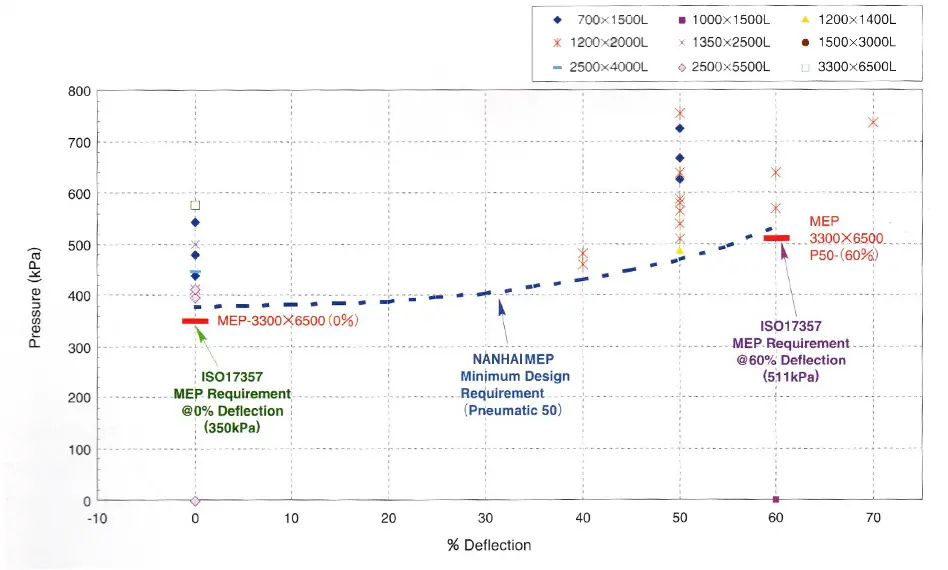How to install tugboat cylindrical fenders on the boat?
07/04/2025What Is an Element Rubber Fender?
07/07/2025How Yokohama Fenders Absorb Shock?
Yokohama fenders, also known as pneumatic rubber fenders, are essential shock absorbers in ports and for ships. NANHAI Company‘s Yokohama fenders primarily use compressed air inside them to soak up shock, protecting ships and port structures when vessels berth (dock) and moor.
The shock absorption principle of Yokohama fenders
NANHAI Company‘s Yokohama fenders work like a big, tough “balloon” filled with compressed air. When a ship touches the fender, the fender squishes down, and the air inside gets squeezed. This action effectively absorbs the ship’s energy from the impact.
- Air as the Cushion: Unlike solid rubber or foam fenders, Yokohama fenders use compressed air as their main shock absorber.
- Energy Soaking and Gentle Pushback: When the air gets squeezed, it can absorb a lot of impact energy. A key advantage is that they push back with a relatively low force. This means even though they absorb a lot of energy, they don’t hit the ship’s hull or the dock hard. This helps prevent damage to both the ship and the port.
- Even Pressure Spread: The compressed air inside helps spread the impact force evenly across the fender’s surface. This is really helpful when a ship docks at an angle, where solid fenders might get stressed in just one spot. The flexible design lets the fender hug the ship’s shape better, spreading the pressure more effectively.

Strong Build and Materials
The tough construction of NANHAI Company‘s Yokohama fenders is vital to how they work. They usually consist of several layers of strong, rubber sheets reinforced with synthetic tire cords.
- Outer Rubber Layer: This layer protects against scrapes, sun damage, and harsh ocean conditions.
- Inner Rubber Layer: This keeps the air sealed inside and maintains the correct air pressure.
- Cord Layers: These reinforcing layers are placed at specific angles. They help the fender hold its internal pressure and spread stress evenly, preventing punctures and making sure it lasts a long time.

Why Yokohama Fenders Are Important
NANHAI Company‘s Yokohama fenders play a very important role in today’s shipping world. Here’s why they matter so much:
1. Protecting Ships and Port Structures
Without good cushioning, ships and port structures can easily get damaged during docking. NANHAI Company‘s Yokohama fenders absorb the impact force, greatly reducing the risk of damage to ship hulls, sides, dock walls, and mooring posts. This saves a lot of money on repairs and avoids delays in port operations.
2. Adapting to Tides and Ship Movements
Because they’re filled with air, NANHAI Company‘s Yokohama fenders float, making them easy to set up and move. Their ability to float also lets them easily adjust to changing tides and how ships move up and down. They always stay in the best position to cushion impacts, providing constant protection.
3. Making Docking Safer and More Efficient
The low pushback force of NANHAI Company‘s Yokohama fenders makes docking smoother and safer. Ship crews can dock with more confidence, reducing jolts and dangers from hard impacts. This not only makes docking faster but also creates a safer working environment for crews and port staff.
4. Wide Use and High Adaptability
NANHAI Company‘s Yokohama fenders are used almost everywhere in the shipping industry, on all types of ships and in all kinds of ports. You’ll find them with large oil tankers, container ships, passenger ships, military vessels, and research ships. They work well with different dock types, including fixed docks, floating docks, and even during ship-to-ship transfers. Their versatility and ability to adapt make them a key part of marine engineering.
In short, NANHAI Company‘s Yokohama fenders, with their unique air-cushioning design, strong build, and great adaptability, offer reliable protection for ships and ports, ensuring safe and efficient shipping operations.
